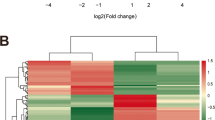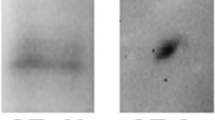Abstract
Selenium, a micronutrient, is indispensable for maintaining normal metabolic functions in animals and plants. Selenium has shown promise in terms of its effect on the immune function, ability to control inflammation, and ability to improve bovine mammary gland health. Bovine mastitis remains a major threat to dairy herds globally and has economically significant impacts. The exosomes are a new mode of intercellular communication. Exosomal transfer of mRNAs, microRNAs, and proteins between cells affects the protein production of recipient cells. The development of novel high-throughput omics approaches and bioinformatics tools will help us understand the effects of selenium on immunobiology. However, the differential expression of mRNAs in bovine mammary epithelial cell–derived exosomes has rarely been studied. In the present study, differences in the exosomal transcriptome between control and selenium-treated MAC-T cells were identified by RNA sequencing and transcriptome analysis. The results of mRNA profiling revealed 1978 genes in exosomes that were differentially expressed between the selenium-treated and control cells. We selected and analyzed 91 genes that are involved in inflammation, redox reactions, and immune cell function related to mastitis. Gene ontology (GO) and Kyoto Encyclopedia of Genes and Genomes (KEGG) analyses revealed enrichment pathways involved in selenoproteins and the Ras/PI3K/AKT, MAPK, and FOXO signaling pathways. Our results revealed that selenium may play a crucial role in immune and inflammatory regulation by influencing the differential expression of exosomal mRNAs of key genes in bovine mastitis.



Similar content being viewed by others
Abbreviations
- DEGs:
-
differential expression genes
- FOXO:
-
forkhead box O
- GO:
-
gene Ontology
- GPx:
-
glutathione peroxidases
- IL:
-
interleukin
- KEGG:
-
Kyoto Encyclopedia of Genes and Genomes
- MAPK:
-
mitogen-activated protein kinase
- NF-κB:
-
nuclear transcription factor-kappa B
- NTA:
-
nanoparticle tracking analysis
- PI3K:
-
phosphoinositide 3-kinases
- ROS:
-
reactive oxygen species
- SELENOK:
-
selenoprotein K
- SELP:
-
selenoprotein P
- TEM:
-
transmission electron microscopy
- TrxR:
-
thioredoxin reductases
- TXN:
-
thioredoxin
- TXNIP:
-
thioredoxin-interacting protein
- TXNRDs:
-
thioredoxin reductases
References
Mehdi Y, Hornick JL, Istasse L, Dufrasne I (2013) Selenium in the environment, metabolism and involvement in body functions. Molecules 18:3292–3311
Zeng H (2009) Selenium as an essential micronutrient: roles in cell cycle and apoptosis. Molecules 14:1263–1278
Avery J, Hoffmann P (2018) Selenium, Selenoproteins, and immunity. Nutrients 10:1203
Wang N, Tan H, Li S, Xu Y, Guo W, Feng Y (2017) Supplementation of micronutrient selenium in metabolic diseases: its role as an antioxidant. Oxidative Med Cell Longev 2017:7478523
Catherine M (2015) Selenium and chronic diseases: a nutritional genomics perspective. Nutrients 7:3621–3651
Daniels LA (1996) Selenium metabolism and bioavailability. Biol Trace Elem Res 54:185–199
Rayman MP (2018) The importance of selenium to human health. Lancet 2000:233–241
Chen X, Yang G, Chen J, Chen X, Ge K (1980) Studies on the relations of selenium and Keshan disease. Biol Trace Elem Res 2:91–107
N. Council, C. National (2001) Nutrient requirements of dairy cattle: seventh revised edition. National Research Council, Washington, DC, 2001
Suttle NF (2009) Mineral nutrition of livestock. Cabi Bookshop, 215(6):1–8
Henriques M, Gomes F (2016) Control of bovine mastitis: old and recent therapeutic approaches. Curr Microbiol 72(4):377–382
Motaung TE, Petrovski KR, Petzer IM, Thekisoe O, Tsilo TJ (2017) Importance of bovine mastitis in Africa. Anim Health Res Rev 18:1
Cantón R, Morosini M (2011) Emergence and spread of antibiotic resistance following exposure to antibiotics. FEMS Microbiol Rev 35:977–991
Bradley A (2002) Bovine mastitis: an evolving disease. Vet J 164:116–128
Boyne R, Arthur J (1979) Alterations of neutrophil function in selenium-deficient cattle. J Comp Pathol 89:151–158
Roy M, Kiremidjian-Schumacher L, Wishe H, Cohen M, Stotzky G (1994) Supplementation with selenium and human immune cell functions. I. Effect on lymphocyte proliferation and interleukin 2 receptor expression. Biol Trace Elem Res 41:103–114
Liu K, Ding T, Fang L, Cui L, Li J, Meng X, Zhu G, Qian C, Wang H, Li J (2020) Staphylococcus aureus organic selenium ameliorates -induced mastitis in rats by inhibiting the activation of NF-κB and MAPK signaling pathways. Front Vet Sci 7:443
Wang H, Bi C, Wang Y, Sun J, Meng X, Li J (2018) Selenium ameliorates Staphylococcus aureus-induced inflammation in bovine mammary epithelial cells by inhibiting activation of TLR2, NF-κB and MAPK signaling pathways. BMC Vet Res 14:197
Console L, Scalise M, Indiveri C (2019) Exosomes in inflammation and role as biomarkers. Clin Chim Acta 488:165–171
Colombo M, Raposo GA, Théry C (2014) Biogenesis, secretion, and intercellular interactions of exosomes and other extracellular vesicles. Annu Rev Cell Dev Biol 30:255–289
Tan SS, Yin Y, Lee T, Lai RC, Yeo RWY, Zhang B, Choo A, Lim SK (2013) Therapeutic MSC exosomes are derived from lipid raft microdomains in the plasma membrane. J Extracell Vesicles 2:1–10
Kato T, Miyaki S, Ishitobi H, Nakamura Y, Nakasa T, Lotz MK, Ochi M (2014) Exosomes from IL-1β stimulated synovial fibroblasts induce osteoarthritic changes in articular chondrocytes. Arthritis Res Ther 16:R163
Wieckowski EU, Visus C, Szajnik M, Szczepanski MJ, Storkus WJ, Whiteside TL (2009) Tumor-derived microvesicles promote regulatory T cell expansion and induce apoptosis in tumor-reactive activated CD8+ T lymphocytes. J Immunol 183:3720–3730
Gupta A, Pulliam L (2014) Exosomes as mediators of neuroinflammation. J Neuroinflammation 11:68
Ying W, Riopel M, Bandyopadhyay G, Dong Y, Birmingham A, Seo J, Ofrecio J, Wollam J, Hernandez-Carretero A, Fu W, Li P, Olefsky J (2017) Adipose tissue macrophage-derived exosomal miRNAs can modulate in vivo and in vitro insulin sensitivity. Cell 171:372–384.e312
Lässer C, Eldh M, Lötvall J (2012) Isolation and characterization of RNA-containing exosomes. J Vis Exp:e3037. https://doi.org/10.3791/3037
Wang X, Xu C, Hua Y, Sun L, Cheng K, Jia Z, Han Y, Dong J, Cui Y, Yang Z (2016) Exosomes play an important role in the process of psoralen reverse multidrug resistance of breast cancer. J Exp Clin Cancer Res 35:186
Hatfield DL, Berry MJ, Gladyshev VN (2002) Selenium: Its molecular biology and role in human health. Free Radic Res 36:2:235. https://doi.org/10.1080/10715760290006394
Sordillo LM (2013) Selenium-dependent regulation of oxidative stress and immunity in periparturient dairy cattle. Med-Vet International 2013:154045
Burk RF, Hill KE (2009) Selenoprotein P-expression, functions, and roles in mammals. Biochim Biophys Acta 1790:1441–1447
Brigelius-Flohé R, Maiorino M (2013) Glutathione peroxidases. Biochim Biophys Acta 1830:3289–3303
Yang J, Hamid S, Liu Q, Cai J, Xu S, Zhang Z (2017) Gene expression of selenoproteins can be regulated by thioredoxin(Txn) silence in chicken cardiomyocytes. J Inorg Biochem 177:118–126
Wen Y, Liu Y, Tang T, Pan M, Xu S, Ma K, Lv L, Liu H, Liu B (2018) mROS-TXNIP axis activates NLRP3 inflammasome to mediate renal injury during ischemic AKI. Int J Biochem Cell Biol 98:43–53
Ganther HE, Baumann CA (1962) Selenium metabolism. J Nutr 77:210–216
Liu J, Srinivasan P, Pham DN, Rozovsky S (2012) Expression and purification of the membrane enzyme selenoprotein K. Protein Expr Purif 86:27–34
Gao X, Xing H, Li S, Li J, Ying T, Xu S (2012) Selenium regulates gene expression of selenoprotein W in chicken gastrointestinal tract. Biol Trace Elem Res 145:181–188
Kipp A, Banning A, van Schothorst E, Méplan C, Schomburg L, Evelo C, Coort S, Gaj S, Keijer J, Hesketh J, Brigelius-Flohé R (2009) Four selenoproteins, protein biosynthesis, and Wnt signalling are particularly sensitive to limited selenium intake in mouse colon. Mol Nutr Food Res 53:1561–1572
West A (2017) Mitochondrial dysfunction as a trigger of innate immune responses and inflammation. Toxicology 391:54–63
Wang S, Li X, Wang W, Zhang H, Xu S (2019) Application of transcriptome analysis: oxidative stress, inflammation and microtubule activity disorder caused by ammonia exposure may be the primary factors of intestinal microvilli deficiency in chicken. Sci Total Environ 696:134035.134031–134035.134010
Johnson D, Chen Y (2012) Ras family of small GTPases in immunity and inflammation. Curr Opin Pharmacol 12:458–463
Aksamitiene E, Kiyatkin A, Kholodenko B (2012) Cross-talk between mitogenic Ras/MAPK and survival PI3K/Akt pathways: a fine balance. Biochem Soc Trans 40:139–146
Jiang A, Zhang Y, Zhang X, Wu D, Liu Z, Li S, Liu X, Han Z, Wang C, Wang J, Wei Z, Guo C, Yang Z (2020) Morin alleviates LPS-induced mastitis by inhibiting the PI3K/AKT, MAPK, NF-κB and NLRP3 signaling pathway and protecting the integrity of blood-milk barrier. Int Immunopharmacol 78:105972
Jing H, Zhang Q, Li S, Gao XJ (2020) Pb exposure triggers MAPK-dependent inflammation by activating oxidative stress and miRNA-155 expression in carp head kidney. Fish Shellfish Immunol 106:219–227
Nagarajan S, Bedi U, Budida A, Hamdan F, Mishra V, Najafova Z, Xie W, Alawi M, Indenbirken D, Knapp S, Chiang C, Grundhoff A, Kari V, Scheel C, Wegwitz F, Johnsen S (2017) BRD4 promotes p63 and GRHL3 expression downstream of FOXO in mammary epithelial cells. Nucleic Acids Res 45:3130–3145
Jing H, Wang S, Wang Y, Shen N, Gao XJ (2020) Environmental contaminant ammonia triggers epithelial-to-mesenchymal transition-mediated jejunal fibrosis with the disassembly of epithelial cell-cell contacts in chicken. Sci Total Environ 726:138686
Brunet A, Bonni A, Zigmond M, Lin M, Juo P, Hu L, Anderson M, Arden K, Blenis J, Greenberg M (1999) Akt promotes cell survival by phosphorylating and inhibiting a Forkhead transcription factor. Cell 96:857–868
Zhang M, Zhang X (2019) The role of PI3K/AKT/FOXO signaling in psoriasis. Arch Dermatol Res 311:83–91
Li B, Xi P, Wang Z, Han X, Xu Y, Zhang Y, Miao J (2018) PI3K/Akt/mTOR signaling pathway participates in Streptococcus uberis-induced inflammation in mammary epithelial cells in concert with the classical TLRs/NF-ĸB pathway. Vet Microbiol 227:103–111
Author information
Authors and Affiliations
Corresponding author
Ethics declarations
Conflict of Interest
The authors declare that they have no conflict of interest.
Additional information
Publisher’s Note
Springer Nature remains neutral with regard to jurisdictional claims in published maps and institutional affiliations.
Rights and permissions
About this article
Cite this article
Jing, H., Chen, Y., Liang, W. et al. Effects of Selenium on MAC-T Cells in Bovine Mastitis: Transcriptome Analysis of Exosomal mRNA Interactions. Biol Trace Elem Res 199, 2904–2912 (2021). https://doi.org/10.1007/s12011-020-02439-7
Received:
Accepted:
Published:
Issue Date:
DOI: https://doi.org/10.1007/s12011-020-02439-7




